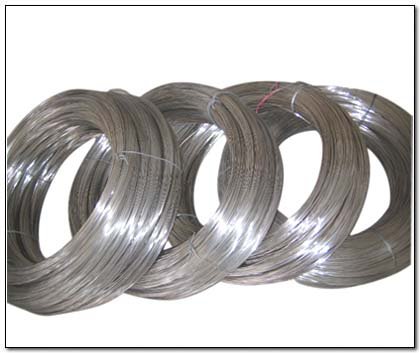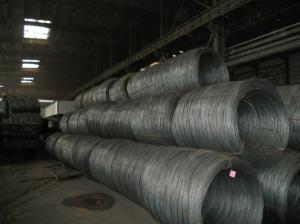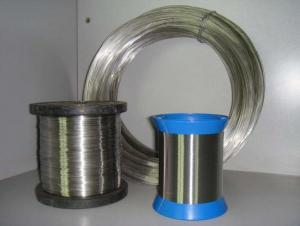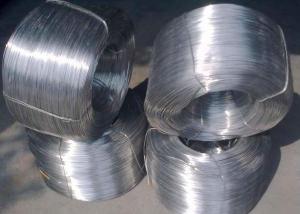Stainless Steel Wire Rod
- Loading Port:
- China Main Port
- Payment Terms:
- TT or LC
- Min Order Qty:
- 1 Ton m.t.
- Supply Capability:
- 2000 Tons Per Month m.t./month
OKorder Service Pledge
OKorder Financial Service
You Might Also Like
304 Stainless Steel Wire
1.Grade: SS 200,300,400 series
2.Dia: 0.1mm-100mm
3.Length:500m-2000m/Reel
4.Surface: Bright
5.Certificate: Fortune 500, SGS, ISO 9001:2008
6.Test: Salt Spray over200 hours
7.MOQ:500kg
8.Delivery: Within 20 days
9.Packing: Reel, wooden box or according to your requirement
10.Payment terms: China Main Port or CIF ANY PORT
11. Application: Tie wire, pins, lashing, forming wire, filters, gaskets, elevators, safety wire, shaped and flat wire, conveyors, jewelry, springs, brush welding, electrical, wire line, craft and many more applications.
|
Main Grades |
C % |
Si % |
S % |
P % |
Mn % |
Cr % |
Ni % |
Mo % |
Cu % |
|
S30400 |
<0.08 |
<0.75 |
<0.015 |
<0.045 |
<2 |
18.05-19 |
8.01--8.25 |
<0.6 | |
|
304H |
0.04-0.1 |
<0.75 |
<0.015 |
<0.045 |
<2 |
18.05-19 |
8.01--8.25 |
<0.5 | |
|
304Hc1 |
0.03-0.05 |
<0.75 |
<0.015 |
<0.045 |
<2 |
18.05-19 |
8.01-8.25 |
1.2-1.6 | |
|
304Hc |
0.03-0.05 |
<0.75 |
<0.015 |
<0.045 |
<2 |
18.05-19 |
8.01--8.25 |
2-3 | |
|
304Hc3 |
0.03-0.05 |
<0.75 |
<0.015 |
<0.045 |
<2 |
18.05-19 |
8.01--8.25 |
3-3.5 | |
|
304ES |
<0.08 |
<0.75 |
<0.015 |
<0.045 |
2-3 |
16.05-17 |
6.01-6.3 |
1.5-3 | |
|
304M2 |
0.05-0.08 |
<0.75 |
<0.015 |
<0.045 |
2-3 |
18-18.5 |
7-8.1 |
<0.6 | |
|
304M3 |
0.05-0.08 |
<0.75 |
<0.015 |
<0.045 |
2-3 |
18-18.5 |
8.01-8.25 |
<0.6 | |
|
304L |
<0.035 |
<0.75 |
<0.015 |
<0.045 |
<2 |
18.05-19 |
8.01--8.25 |
<0.6 | |
|
321 |
0.04-0.08 |
<0.75 |
<0.015 |
<0.045 |
<2 |
17-18 |
8.01--8.25 |
||
|
316L |
<0.035 |
<0.75 |
<0.015 |
<0.045 |
<2 |
16.05-17 |
10.01--10.35 |
2.01-2.2 |
<1 |
|
316 |
0.04-0.08 |
<0.75 |
<0.015 |
<0.045 |
<2 |
16.05-17 |
10.01--10.35 |
2.01-2.2 |
<1 |
|
316LCu |
<0.035 |
<0.75 |
<0.05 |
<0.045 |
<2 |
16-17 |
10-10.5 |
2-2.25 |
|
|
ER316L |
<0.04 |
0.65 |
<0.03 |
<0.04 |
1.0-2.5 |
18-20 |
11.1-12 |
||
|
201CU |
<0.08 |
<0.75 |
<0.015 |
<0.045 |
8-9.5 |
13.05-14 |
4.01-4.25 |
2-3 | |
|
D667 |
<0.08 |
<0.75 |
<0.015 |
<0.045 |
13-14 |
13-14 |
0.7-1.5 |
1.5-3 | |
|
D665B |
<0.08 |
<0.75 |
<0.015 |
<0.045 |
14-16 |
10.05-11 |
<1.2 |
0.5--1.5 | |
|
202B |
0.1-0.15 |
<0.75 |
<0.015 |
<0.045 |
9-10 |
17.05-18 |
4.5-5 |
||
|
D669 |
0.08-1.0 |
<0.75 |
<0.015 |
<0.045 |
14.5-16 |
11-12 |
<1.2 |
0.5-1.5 | |
|
200CU |
<0.08 |
<0.75 |
<0.015 |
<0.045 |
11-12 |
13-14 |
1-2 |
1.5-2.5 |


- Q: Can stainless steel wire be used for making wire hangers?
- Indeed, wire hangers can be crafted from stainless steel wire. The preference for stainless steel as a material for wire hangers arises from its commendable qualities such as sturdiness, resilience, and ability to resist rust and corrosion. This adaptable material can endure substantial weight and retain its form for an extended period. Consequently, stainless steel wire hangers find widespread usage in homes, retail establishments, and dry cleaning enterprises as they offer a trustworthy and enduring means of suspending garments. Furthermore, stainless steel wire hangers present an environmentally conscious alternative to plastic hangers, as they can be recycled and reused indefinitely.
- Q: Is it necessary to make barbecue with argon arc welding wire (stainless steel)?
- Because the composition of stainless steel wire itself is higher than stainless steel purity, high-grade, and ordinary stainless steel nowCan also be used in the medical, food machinery industry.
- Q: What are the different weaving patterns for stainless steel wire mesh?
- There are several different weaving patterns used for stainless steel wire mesh, each with its own unique characteristics and applications. Some of the most common weaving patterns include: 1. Plain Weave: This is the simplest and most common weaving pattern, where each wire passes alternately over and under the adjacent wires, creating a crisscross pattern. It provides a strong and durable mesh with good filtration capabilities. 2. Twilled Weave: In this pattern, each wire passes over two and under two adjacent wires, creating a diagonal pattern. Twilled weave meshes have increased stability and strength, making them suitable for heavy-duty applications. 3. Dutch Weave: This pattern utilizes two different wire diameters, with the thicker wires running in the warp direction and the thinner wires in the weft direction. This creates a tight mesh with smaller openings, which is ideal for precise filtration and separation applications. 4. Twilled Dutch Weave: This pattern combines the characteristics of twilled weave and Dutch weave. The wires are woven in a twilled pattern, while the thinner wires are used to create smaller openings. This results in a strong and fine mesh suitable for high-pressure filtration and separation processes. 5. Reverse Weave: Also known as reverse plain weave, this pattern is similar to the plain weave but with the warp and weft wires reversed. It creates a smooth and flat surface, making it ideal for architectural and decorative applications. 6. Satin Weave: This pattern is characterized by multiple warp wires passing over one weft wire, followed by multiple weft wires passing over one warp wire. It produces a tight and smooth mesh with a lustrous appearance, often used for decorative purposes. These different weaving patterns offer a range of mesh characteristics such as strength, stability, filtration capabilities, and appearance. The choice of weaving pattern depends on the specific application requirements, such as particle size to be filtered, pressure resistance, or desired aesthetic appeal.
- Q: Can stainless steel wire be used for suspension bridges?
- Yes, stainless steel wire can be used for suspension bridges. Stainless steel is a highly durable and corrosion-resistant material, making it ideal for applications in harsh environments, such as bridges. The use of stainless steel wire in suspension bridges offers numerous advantages. Firstly, stainless steel's resistance to corrosion ensures that the wire will not degrade over time, even when exposed to moisture, saltwater, or other corrosive elements. This enhances the overall structural integrity and longevity of the bridge. Secondly, stainless steel wire has high tensile strength, which means it can withstand heavy loads and provide excellent support for the bridge. This is crucial for suspension bridges, where the weight of the bridge and the traffic it carries is primarily supported by the cables. Lastly, stainless steel wire is lightweight and flexible, allowing for easier installation and maintenance of the suspension bridge. Overall, the use of stainless steel wire in suspension bridges offers a reliable and long-lasting solution that can withstand the demands of such a structure.
- Q: Can stainless steel wire be used for wire bending?
- Yes, stainless steel wire can be used for wire bending. Stainless steel is a strong and durable material that can be easily manipulated and shaped without breaking, making it suitable for various wire bending applications.
- Q: What's the difference between galvanized iron wire and stainless steel wire?
- Stainless steel wire is chromium containing without nickel, also known as Cr stainless steel wire, there is a certain corrosion resistance. Stainless steel, generally considered ferromagnetic, mainly refers to the 1Cr17 (ferrite) series and 1Cr13 (martensite) series, while Fe is not ferromagnetic in the presence of austenite.
- Q: What are the different types of stainless steel wire rope fittings?
- For various applications, there is a wide range of stainless steel wire rope fittings to choose from. Some of the fittings commonly used include: 1. Thimbles: Thimbles serve the purpose of protecting the wire rope from wear and tear, as well as creating a loop or eye in the wire rope. They come in different sizes and shapes, including standard, heavy-duty, and oval thimbles. 2. Wire rope clips: Known also as cable clamps or U-bolts, wire rope clips are utilized to secure the loose end of a wire rope to the standing part. They consist of a U-shaped bolt, a saddle, and two nuts. Wire rope clips are available in various sizes to match the diameter of the wire rope being used. 3. Turnbuckles: Adjusting the tension in a wire rope is achieved through the use of turnbuckles. They consist of a body with threaded ends, one right-hand and one left-hand, along with an eye or hook on each end. By rotating the body, the length of the turnbuckle can be adjusted, thereby changing the tension in the wire rope. 4. Swage fittings: Swage fittings are employed to terminate wire rope by crimping or swaging the fitting onto the wire rope. They are available in different forms, such as swage studs, swage forks, and swage eyes. Swage fittings ensure a secure and permanent termination for wire ropes. 5. Shackles: To connect two wire ropes or to connect a wire rope to an anchor point, shackles are used. Bow shackles, D shackles, and screw pin shackles are among the different types available. Shackles find common use in lifting and rigging applications. 6. Hooks: Hooks are utilized to connect a wire rope to a load or an anchor point. They come in various forms, including eye hooks, clevis hooks, and swivel hooks. Hooks find wide-ranging applications, from lifting heavy loads to securing objects. These examples represent just a fraction of the stainless steel wire rope fittings available. The selection of a fitting should be based on the specific application, load requirements, and environmental conditions. Choosing the appropriate fitting is vital to ensure the safety and reliability of the wire rope system.
- Q: What are the different types of stainless steel wire rope constructions?
- There are several different types of stainless steel wire rope constructions, including 1x19, 7x7, and 7x19. The 1x19 construction consists of a single strand with 19 wires, offering high strength and minimal flexibility. The 7x7 construction has seven strands, each consisting of seven wires, providing a balance between strength and flexibility. Lastly, the 7x19 construction has seven strands, each consisting of 19 wires, offering maximum flexibility but slightly less strength compared to the other constructions.
- Q: Can stainless steel wire be used for welding electrodes?
- Yes, stainless steel wire can be used for welding electrodes. It is commonly used in applications that require corrosion resistance and high strength, such as in the welding of stainless steel materials.
- Q: Can stainless steel wire be used for hanging plants?
- Yes, stainless steel wire can be used for hanging plants. It is a durable and strong material that can support the weight of plants, making it suitable for hanging purposes. Additionally, stainless steel is resistant to rust and corrosion, which ensures longevity when exposed to moisture in plant environments.
Send your message to us
Stainless Steel Wire Rod
- Loading Port:
- China Main Port
- Payment Terms:
- TT or LC
- Min Order Qty:
- 1 Ton m.t.
- Supply Capability:
- 2000 Tons Per Month m.t./month
OKorder Service Pledge
OKorder Financial Service
Similar products
Hot products
Hot Searches
Related keywords




























